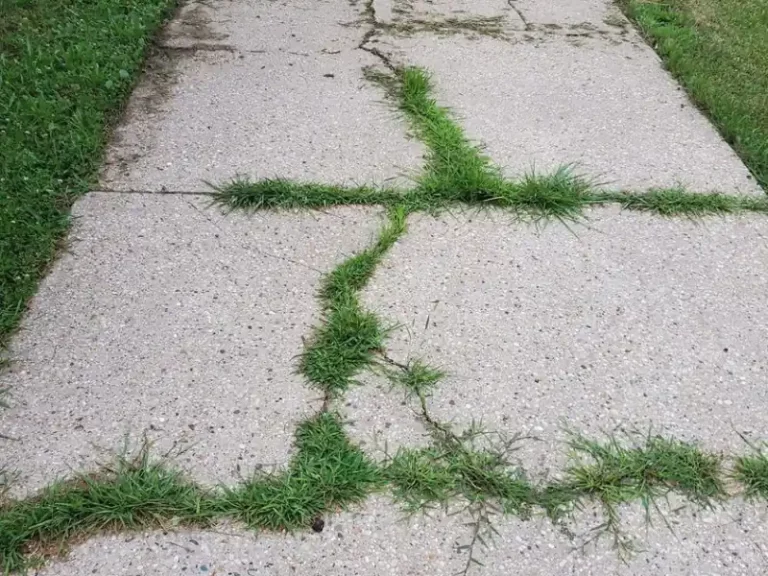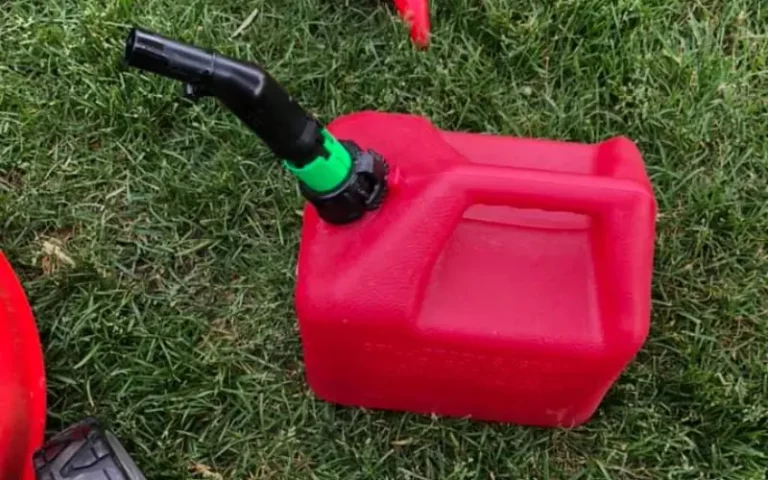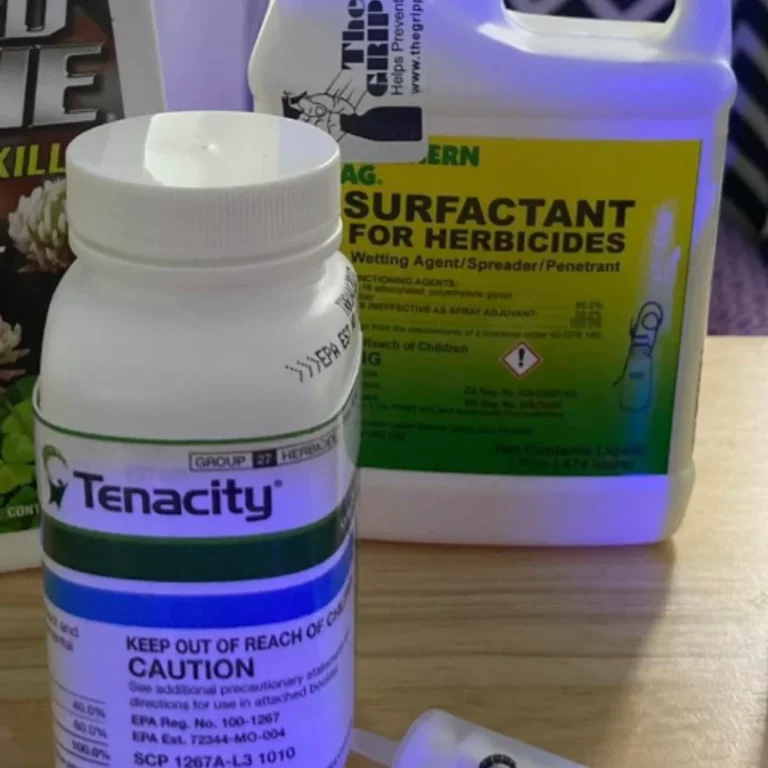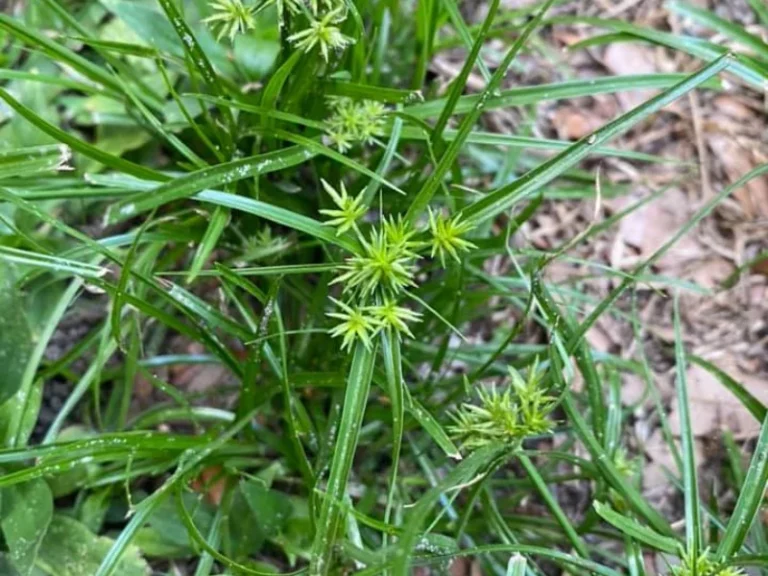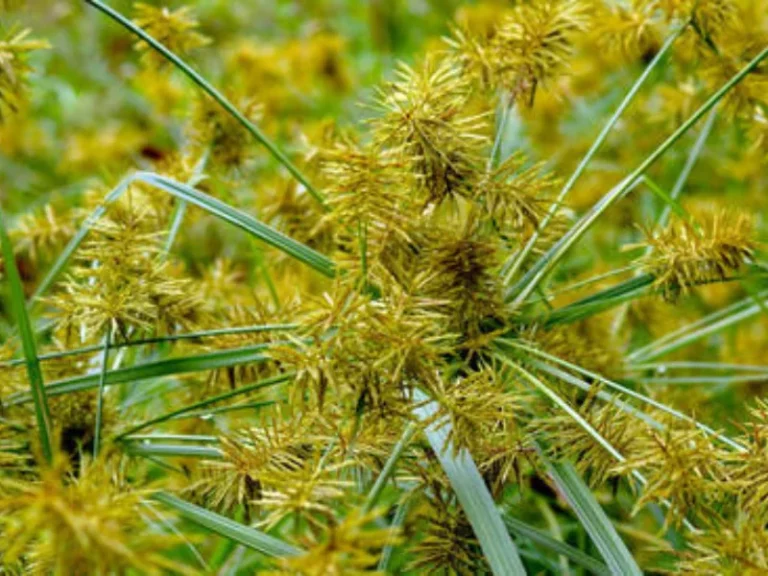How to Get Rid of Ragweed

Each year, ragweed, releases clouds of allergy-inducing pollen grains in many parts of North America that cause hay fever in many people. This persistent weed spreads aggressively, overtaking lawns and gardens.
To get rid of ragweed, manually uproot them in early summer before they flower. For large infestations, apply herbicides like 2,4-D amine in spring and early summer. Also, mow frequently in late spring through summer to prevent ragweed from flowering.
Getting rid of this weed takes some work and it’s a seasonal struggle for most landowners. Below I have outlined the best and proven effective methods to identify, manage, and eradicate this nuisance plant.
What is ragweed?
Ragweed (Ambrosia trifida) is an upright flowering herb native to North America. It is a member of the large Asteraceae family of flowering plants, including daisies, sunflowers, and asters. It also goes by hogweed, stammerwort, hayweed, hayfever weed, carrot weed, blackweed, annual ragweed, bitterweed, hogbrake, wild tansy, and Roman wormwood.
This weed germinates during spring from March to May and can grow over 10 feet tall and spreads through its copious seed production, with a single plant producing up to 60,000 seeds.

Ragweed is characterized by stout, green to light pinkish-red hairy stems and large, blue-green, hairy young leaves and mature hairless leaves that are palmately compound leaves arranged oppositely along the stem. The leaves are made up of 3-5 lobes, serrated along the edges, have a flat, thin texture, and have a dimension of up to 6 inches long and 4 inches across.
From summer to fall, ragweed produces many small green about 20cm long flowers clustered into spikes near the top of the plant. These inconspicuous flowers later develop into green spherical fruits containing viable seeds for 5 years or more. The fruits can be smaller than a quarter or larger than a credit card.
An important identifying feature of ragweed is the change in leaf arrangement as you move up the stem – leaves near the base have long petioles, while leaves higher on the stem have much shorter petioles.
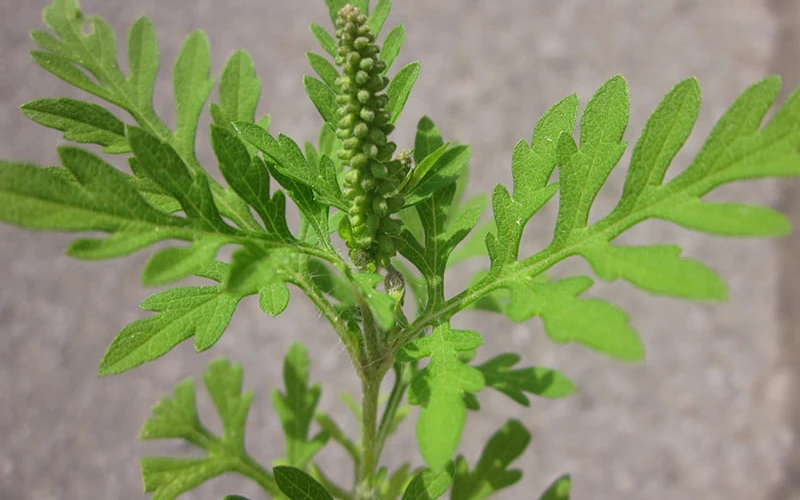
Ragweed thrives in full or partial sun, in disturbed soil near buildings, and can survive in low moisture areas due to low competition. It then spreads quickly across salting roads during winter, landscape beds, gardens, riverbanks, fields, and other open sunny sites.
Despite its negative effects as a weed, ragweed is also beneficial. You can harvest its roots and leaves before they flower and brew tea. The tea has some strong anti-inflammatory and mucus-clearing properties.
It can help alleviate fevers, pneumonia, congestion, and skin irritation from insect bites. Additionally, ragweed is also a great companion plant for pepper, it will protect pepper plants from leafminers, which prefer chewing on them.
Benefits aside, ragweed has negative health impacts. Around late summer and fall (mid-September), ragweed’s pollen causes seasonal allergic rhinitis, or rather call it hay fever. Sneezing, runny nose, headaches, irritated eyes, and itchy throat accompany the allergy.
How to get rid of ragweed
I’ve found and used several effective methods to eradicate ragweed. Manual uprooting can eliminate young plants, while frequent mowing helps curb their growth and seed production. Herbicides that specifically target ragweed are also quite effective.
And surprisingly, even regular household vinegar can destroy ragweed. Each approach has its pros and cons to weigh. I will show you how to use each method. Let’s get to it!
1. Manual removal (Uprooting)
Manually uprooting ragweed is an easier, cheaper, chemical-free, and effective method for small infestations. This is my preferred method of getting rid of ragweed, as it feels like I am giving them a scolding as I pull them up!

Tools needed:
- Garden gloves
- Long sleeves and pants
- Shovel or trowel
- Weed puller tool
- Trash bags
Procedure:
- Wear protective garden gloves, long sleeves, and pants to minimize contact with the plant.
- Use a shovel or trowel to loosen the soil around the ragweed plant, especially around the base of the stem.
- Firmly grasp the stem as close to the base as possible.
- Slowly pull the ragweed straight up and out of the ground.
- Attempt to remove as much of the root system as possible for thorough elimination. Use a weed puller tool if you need extra muscle but it is generally easy to pull.
- Carefully place the uprooted weeds in trash bags to prevent them from re-rooting or spreading their seeds.
- Check the area for any broken roots or plant fragments left behind, and remove them.
Precautions:
- Avoid contact with your skin, eyes, and nose to prevent some mild irritations from pollen.
- Thoroughly wash your hands and clothes after removal.
- For those with ragweed allergies: The smell and pollen from ragweed can be tough on you. Avoid touching or pulling it. If you’re prone to allergies, avoid flowering plants and their pollen.
2. Mowing/Cutting
Proper timing is key for mowing to control ragweed effectively. I recommend you to mow during July and August, before the plant flowers and sets seed. This way, you will prevent ragweeds from maturing and spread seeds while re-sprouting.
Set your lawnmower height to 3-4 inches and mow ragweed every 2-3 weeks. This repeatedly cuts back growth while leaving roots undamaged. Over time, if you consistently mow it will cause the roots to rot and die.
Pro tip: Do not mow a mature, flowering ragweed as this can spread seeds and worsen the problem. I recommend you to mow before flowering for the best control. The goal is to exhaust reserves in the roots through repeated cutting back of leafy growth above ground.
3. Herbicide control
For effective ragweed control, herbicides should be applied in mid-spring to early summer, ideally when the plants are still young and haven’t grown beyond 4 inches in height or started flowering. This strategy targets young plants before they can produce pollen, making it more effective.
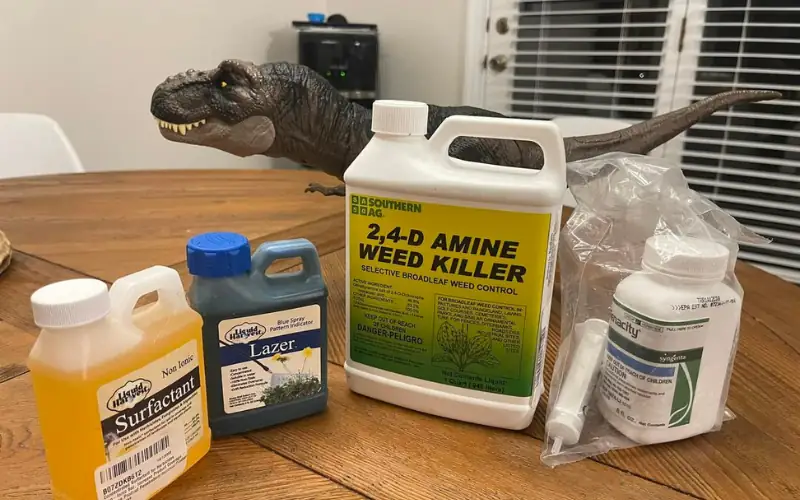
2,4-D Amine Weed Killer has proven more effective against ragweed than other killers. The active ingredient (dichloro-phenoxyacetic acid) works by causing the cells in ragweed tissues responsible for transporting water and nutrients to keep multiplying and growing continuously causing its stems and leaves to wither and wilt which ultimately kills the plant.
To determine the required amount of 2,4-D Amine, first calculate the total area in square meters of the space to be treated. Then mix 2,4-D Amine at the rate of 5 to 7 milliliters per 10 square meters and 2 gallons of water. Then adding 2 milliliters of Alligare 90 surfactant per 10 square meters will improve the sticking and effectiveness of the herbicide application.
Here is a list of items you’ll need:
- Herbicide concentrate (2,4-D amine weed killer)
- Non-ionic surfactant (e.g. Alligare 90)
- Clean water
- Pump sprayer (1-2 gallon capacity recommended)
- Protective equipment: gloves, long sleeves/pants, face shield
Then follow this procedure for proper mixing and application:
- First where your personal protective equipment (PPE)
- Fill the sprayer tank halfway with clean water.
- Add the required amount of 2,4-D amine concentrate into the sprayer. Followed by the non-ionic surfactant (Alligare 90).
- Top off the tank with more water.
- Close the top tightly, shake well then pump the sprayer several times to produce some pressure.
- Thoroughly spray ragweed leaves and stems, wetting plants well but not to runoff.
- Seal off the sprayed area for about 5 hours before any activity is resumed.
- Allow 1-2 weeks to see results as ragweed leaves will wilt, turn yellow, and die.
- Retreat any regrowth on larger infestations. Monitor and spot spray as needed.
- Triple rinse sprayer and containers when finished and store them away from heat or cold drafts.
See: 2,4-D Amine Weed Killer Product Label and Safety Data Sheet here.
CAUTION: Do not use this herbicide in lawns with Bentgrass, St. Augustinegrass, Carpetgrass, and Centipedegrass since it can cause injury to these turfgrasses.
Other effective herbicides that can kill ragweed include glyphosate, dicamba, and fluroxypyr. Always consult and follow label directions on each herbicide.
4. Vinegar
Vinegar is an effective homemade weed killer for controlling ragweed.
For best results against ragweed, use horticultural vinegar that contains 20% acetic acid or higher. The standard 5% household vinegar is too diluted.
Fill a spray bottle with undiluted horticultural vinegar. Adding a few drops of dish soap can help the vinegar stick to and penetrate the waxy leaves. Spot treat ragweed by thoroughly spraying its leaves and stems on a calm, sunny day. Thoroughly wet the foliage but avoid excess runoff.

The acetic acid in the vinegar penetrates the plant, draws moisture out of the leaves, and disrupts cell growth. From my own application, I went back to check on the sprayed ragweed and noticed some wilting. That was first than using herbicides! Monitor and retreat any regrowth.
CAUTION: Vinegar is a non-selective herbicide, so avoid contact with desired plants.
5. Biological control
A research paper convened, presented, and compiled by Dominique Coutinot of the European Biological Control Laboratory, USDA-ARS in France and other researchers were part of a workshop focused on biological control of the invasive weed Ambrosia artemisiifolia (common ragweed) in Europe. The workshop was held in Vienna, Austria in 2006.
From their findings, certain insects can be used to control ragweed naturally.
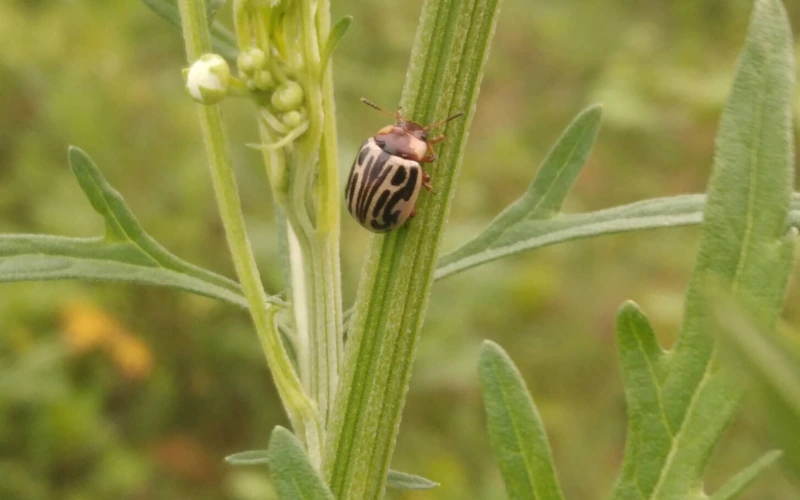
In Australia and Russia, leaf-eating beetles like Zygogramma and Epiblema strenuana from North America have been introduced to combat ragweed. These biological control agents feed on ragweed foliage and stems, damaging the plants.
When is the best time to get rid of ragweed?
The best time for controlling ragweed is in the late summer months before the plant flowers and sets seed. Ragweed blooms from July through October across most regions, releasing copious amounts of pollen that triggers allergies.
Getting rid of ragweed in July and August using the manual, mechanical, or chemical control methods I have mentioned above can significantly reduce the total seed output. This preemptive approach prevents ragweed from propagating and spreading further.
It provides long-term control by destroying them before they disperse about 3 billion pollen and close to 7,000 seeds that will grow into new colonies. Source!
How to prevent ragweed from growing in your lawn
A dense healthy turf is the best defense against weeds like ragweed. Focus on improving lawn density for the following year.
Regular mowing of turfgrasses from late May through June will control ragweed seedlings and minimize growth. Mow frequently to maintain a competitive grass canopy that doesn’t allow gaps for ragweed to establish.
Avoid heavy grazing or haying during the peak ragweed germination period in late spring. This prevents opening up bare spots in the lawn for ragweed to thrive.
Overseed and fertilize to get a denser, healthier lawn that crowds out ragweed. Thick stands of grass limit resources available to ragweed.
Consider pre-emergent herbicides to stop ragweed seeds from sprouting. During spring and fall apply Barricade Pre-emergence Herbicide in your lawn at the rate of 1.5-4 lbs per 1000sq of application area.
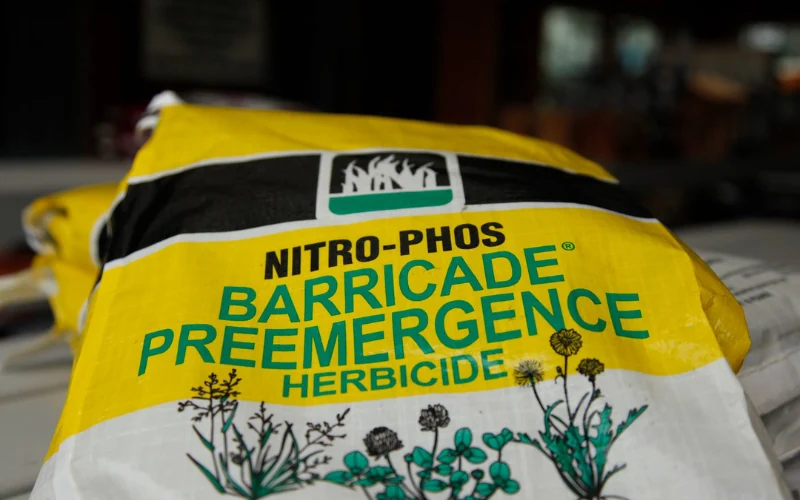
Then finally maintain healthy soil and avoid disturbance which allows dormant ragweed seeds to germinate.
References
- Quensland government: Annual ragweed pdf
FAQs
1. What is the best way to get rid of ragweed?
For me, manually pulling up ragweed by the roots is the best way to eliminate it. Just wear gloves and be thorough in removing all the plant parts from the soil. It’s cheap, easy, and effective for small patches.
2. Does ragweed come back every year?
Unfortunately, yes ragweed does reappear every year. The seeds can survive for many years in the soil waiting to sprout.
3. What kills ragweed naturally?
Vinegar is a natural and organic way to kill ragweed. Look for horticultural vinegar with 20% acetic acid. The acid damages the plant tissues. Boiling water also works to scald and wilt the weeds.
4. How to get rid of ragweed in pasture?
In pastures, the key is to prevent ragweed from going to seed. Mowing or intensive grazing by cattle before flowers form helps curb ragweed. Also overseeding grass helps the turf outcompete ragweed seedlings. Herbicides are another option but avoid spraying near livestock.
Conclusion
After arming yourself with identification tips, control methods, and prevention strategies, you now have all the tools needed to free your property from the allergy-inducing ragweed. But now you can fight back – pull up young sprouts, mow at key times, apply targeted herbicides, release beneficial insects, and nurture lush lawns.

